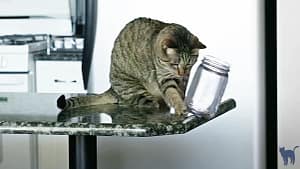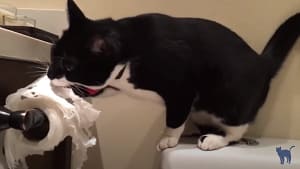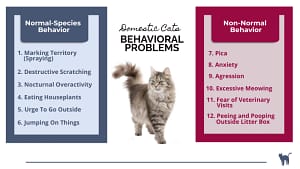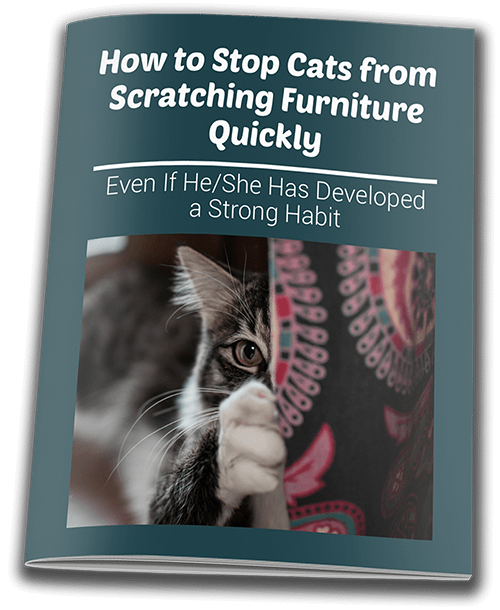Here are the 10 best ways to stop your cat from scratching furniture:
- Provide an appropriate scratching post;
- Make your cat’s preferred furniture unattractive;
- Create cat-free spaces in your home;
- Use a commercial cat repellent;
- Use a gentle but firm tone of voice;
- Calm your cat with FELIWAY® CLASSIC;
- Prevent scratching out of boredom;
- Set aside time to play with your cat;
- Trim cat’s claws to the proper length;
- Cover cat’s nails with Soft Paws®.
Imagine that you have just bought the couch that you wanted so much.
You finally placed it into the living room and sat on it to feel how comfy it was.
But suddenly, your cat shows up.
It starts exploring the new object (as all cats do) and at one point decides to sharpen its claws on it.
Oh, no… DON’T DO IT!!!
Panic takes over and negative feelings towards your pet flourish. You adore your kitty, but you are not going to allow it to destroy the expensive new couch.
It is time to do something….
What are the best ways to prevent cats from scratching furniture?
Don’t worry, there is a solution to this problem.
That’s exactly what you are about to learn today.
So keep reading because once you are finished, you will know exactly how to prevent cats from scratching furniture once and for all.
Best Ways Stop Your Cat from Scratching Furniture (long answer)
Cats scratch things by nature, that’s why no one has to teach a stray cat to scratch a tree trunk.
While scratching behavior is fascinating when observed in outdoor cats, owners of indoor cats seldom hold the same scientific detachment when their pets shred the arm of a $1,500 sofa.
Clearly, the behavior is the same, but when property damage occurs, the results cause much more concern.
If your pet has formed a habit of scratching furniture, door trimming, etc., you’ll need to put some effort to break that habit.
To do so, you can choose from 3 basic strategies:
- The Environmental Strategy (You can change the environment)
- The Behavioral Strategy (You can modify the cat’s behavior)
- Claws Modifications Strategy (You can alter the cat’s claws)
The Environmental Strategy
This strategy involves giving the pet an appealing scratching post while making other areas unattractive. Let’s see what you can do:
- Provide a scratching post your cat really likes;
- Make your cat’s favorite furniture unappealing;
- Close the doors of rooms with special furniture;
- Use a commercial cat repellent.
# 1 Provide a Scratching Post That Your Cat Really Likes

The most important thing to do is to give him or her an alternative surface that is equally or more desirable than the couch, meaning to provide a scratching that fits the cat’s needs.
Make sure that the scratching post is:
- Placed in the area where your pet used to scratch;
- Made of the material that he/she prefers;
- It’s firm and stable.
Still, it could be not enough to solve the problem.
Remember: when it comes to how to keep cats from clawing furniture, this step is critical.
If you’re interested, you can dive deeper into this topic by reading this article:
How to Get Your Cat Use a Scratching Post Fast and Make It Irresistible [7 Tips Inside]
So, your pet may have learned to use the scratching post you bought for him/her, but continues to scratch your furniture.
If this is the case, you will have to go one extra mile to persuade him or her to change its old habits.
Let’s see the other options…
# 2 Make Your Cat's Favorite Piece of Furniture Unappealing
The most logical thing is to make your cat’s favorite furniture unattractive before his/her eyes.
Here are a few options of what you can do:
- Clean the damaged area;
- Utilize double-sided tape;
- Wrap the part in aluminum foil;
- Cover your furniture with plastic;
- Rub orange or lemon peel on the fabric;
- Layout the area with a heavy blanket or with a net.
2.1 Clean the Damaged Area
Make sure that you clean the scratched area to thoroughly remove any traces of the scent markings that would tempt your pet to scratch again.
It’s best to use vinegar or a mild, non-toxic solution that’s appropriate for the piece of furniture’s material, and then keep your feline friend away from it until it’s completely dried.

2.2 Utilize Double-Sided Tape
Deterrent tape is a double-sided tape that you can temporarily apply. For example, to the corner of your couch.
Cats hate the feeling of their paws sticking to the tape when scratching. By doing this, your pet will quickly start to use the nearby scratching post instead.

2.3 Wrap the Part in Aluminum Foil
Cats hate the feeling of aluminum foil, so it should discourage them from scratching.

2.4 Cover Your Furniture with Plastic
Cats don’t like plastic, so covering your furniture with plastic will help until the pet starts to use the pole or tree.
Because it is smooth, this surface will be difficult to scratch, and it can also be easy to clean any fragrance residues.

2.5 Rub Orange or Lemon Peel on the Fabric
Cats dislike the scents of citrus fruits. Scrape orange or lemon peel on the area he or she scratches on.
Citrus odors are widely reported to be at the top of the list of scents that cats despise.

However, we all know that each pet is unique, and yours might not be bothered by it.
In that case, this article includes a large list of scents that most cats dislike:
What Scents Do Cats Not Like? [& Why You Should Be Aware of Them].
2.6 Layout the Area with a Heavy Blanket or Net
If your pet scratches your sofa’s arms, you can discourage this behavior by laying down a heavy blanket.
Your feline friend will hate the new texture, making it scratch elsewhere.
You can also use a net as cats don’t like hooking their claws in it.

Does your cat keep scratching where it shouldn’t?
Do you keep wondering how to keep cats from scratching furniture?
You sure have a very stubborn cat (aren’t they all?).
So, let’s explore other alternatives.
# 3 Close the Doors of Rooms with Special Furniture
Consider leaving these areas a cat-free zone.
Make the whole family aware that no pet should enter the room and always keep the door shut.

Create a cat free zone
Your cat won’t mind al all, so you shouldn’t feel any guilt.
# 4 Use a Commercial Cat Repellent
Cat repellents are liquid solutions containing chemicals that repel cats. It’s not uncommon that these formulas are made from scents they despise. The purpose of cat repellents is to cause rejection by olfactory cues.
This will keep the pet away from your favorite pieces of furniture and prevent it from scratching them.
Remember: use deterrents only when there are other suitable scratching sites available.
It’s a good way to teach your pet without having a direct conflict with him.

Sentry helps cats stop scratching furniture
The Behavioral Strategy
In other cases, environmental changes are not enough to prevent scratching problems.
Some cats won’t scratch a post just because it’s there. They may need some extra encouragement. Here’re four ideas for motivating your pet:
5. Communicate with your cat;
6. Use FELIWAY® CLASSIC;
7. Avoid boredom scratching;
8. Play with your cat.
# 5 Communicate With Your Cat
If you catch your cat in the act of scratching something he/she shouldn’t use a firm tone of voice and words like “no, you shouldn’t scratch that, this is not the place” to interrupt the behavior.

- Don’t punish or yell at him/her. Avoid using the cat’s name during the lecture. They could learn not to scratch when you are present and may continue to scratch when you’re not.
- Don’t get furious with your pet. Remember he/she is only following instincts.
Cats aren’t as trustworthy as dogs, so yelling at them might seriously damage your relationship.
It’s important to redirect the cat’s energy and create positive connections with the place you want it to scratch.
Pick up your cat and carry it gently to the scratching post to show it which is the right place to scratch.
# 6 Use FELIWAY® CLASSIC
FELIWAY® is a brand specialized in feline behavior control. Their products are based on the way cats communicate: through pheromones.
FELIWAY® simulates these pheromones, making cats calmer, more comfortable, and safer. It amplifies their olfactory signals since it contains the pheromone’s synthetic copy along with a small amount of catnip.
As a result, It relaxes them and improves their behavior as well as their relationship with various animals.
How does FELIWAY® CLASSIC spray work?
Spray the product on the area where you do not want your cat to scratch after carefully cleaning it.
The FELIWAY® CLASSIC will then send “happy messages” to provide peace of mind and prevent your cat from scratching the furniture.
Clinical studies have shown that it helps reduce or stop unwanted scratches in the home.

That is the reason why FELIWAY® can be a valid option to direct cats to the scratching post.
Finally, It can only be perceived by cats and produces the same message for all of them. It does not affect humans or other animals that live in the house.
# 7 Avoid Boredom Scratching
Cats, like humans, require mental stimulation and exercise.
If your cat scratches furniture out of boredom or a lack of activity, invest in some toys and make time for some much-needed fun with you and your cat.
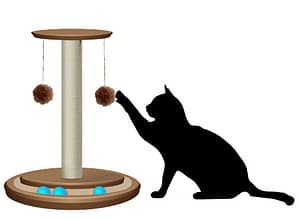
There’re a lot of toys available, especially interactive ones, so your cat is sure to find something he/she will enjoy!
This brings me to the next point…
# 8 Play With Your Cat
You could discourage inappropriate scratching just by playing with him.
The best activities are those that engage a cat’s innate hunting instincts.
You could set up a cat gym or wall shelves (if you have space) to incentivize your cat to jump from place to place.
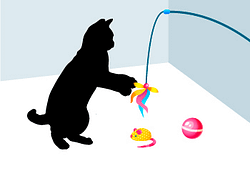
Playing with your cat not only helps prevent behavioral problems but also helps to build a stronger bond with him/her.
The Claws Modification Strategy
If environmental and behavioral strategies don’t work, you can limit your cat’s scratching ability by altering your cat’s claws.
Here are two things you can do:
9. Trim cat’s claws to the proper length;
10. Cover your cat’s nails with Soft Paws®.
# 9 Trim Cat's Claws to the Proper Length
The easiest and most humane way to do so is to regularly trim the cat’s claws. Trim the claws about once a week, and always avoid the blood vessels and nerves in the base of the claws so you do not injure the pet.
This method works very well as a prevention strategy to avoid scratches on furniture, armchairs, or curtains.
Especially if yours is an indoor cat or it leaves the house very little. It also provides benefits to the cat, such as:
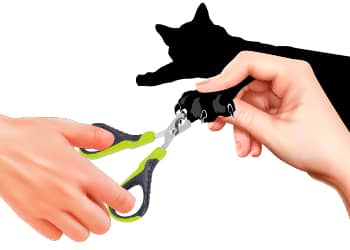
- Keeping the cat’s nails in good condition;
- Preventing diseases and infections.
Bear in mind that each cat is unique and its particular circumstances will determine whether or not to trim its nails.
If you want to trim your cat’s nails but are unsure how to do it, you could ask your vet or a good groomer in your area.
If you decide to do it yourself, use blunt scissors since they do less damage than sharp ones. And be careful, cutting them too far down to the pink area will hurt the cat and could cause an infection.

# 10 Cover Your Cat's Nails with Soft Paws®
Another option is to apply soft plastic coverings, such as Soft Paws, to the claws. This product was invented by veterinarian Dr. Toby Wexler in 1990. This product was invented by veterinarian Dr. Toby Wexler in 1990.
Soft Paws are nail caps made of vinyl that is attached to your cat’s natural nails. They resemble a cat’s nails, except they’re hollow. This is a fantastic product that works, it’s safe and non-toxic.
The majority of cats tolerate it since they are completely unaware that they are wearing them.
Soft Paws will not interfere with your cat’s regular nail extension and retraction. It’ll enable your cat to scratch normally, allowing typical stretching and scratching behavior to continue without causing damage.


Never Ever Declaw Your Cat
The declawing procedure consists of completely removing a cat’s nails. To do that, it is necessary to amputate the bone of the third phalanx. Cat’s nails are considered extremities since cats use their nails for their most basic functions and are essential for them.
By completing the declawing procedure the cat’s paw, sensory, and motor nerves are severed, injured, and destroyed. The surgery recovery is a long and painful process. Additionally, the pain of declawing lasts a lifetime, and typical cat behavior is lost permanently.

Cats end up unable to enjoy pain-free activities such as walking, running, jumping, climbing, and stretching as a result of this operation
This incapacitating procedure prevents our cats from living a life full of pleasure, energy, and normal cat activities.
Never think about declawing your cat. It’s unnecessary, painful, and debilitating.
According to many studies, cats who have been declawed have a higher percentage of cortisol, the stress hormone, which is commonly connected with pain.
They also tend to have health and behavioral problems for the rest of their life, such as back pain and aggression.
Many European countries, including the United Kingdom, forbid the cat declaw procedure. Unfortunately, it still exists and is practiced clandestinely to this day.
Cat declawing is a criminal practice that I hope will soon be completely eradicated. Don’t be a part of this cruelty.
Warning About Negative Training Methods
Negative training techniques are frequently ineffective. Several cat training techniques try to link negative consequences to bad feline behavior.
Here’s a summary of the most commonly used:
- Spraying your cat in the face with water
- Scaring your cat with very loud noises (like coins inside a can)
- Yelling, hitting, and any other similar strategy.

NO
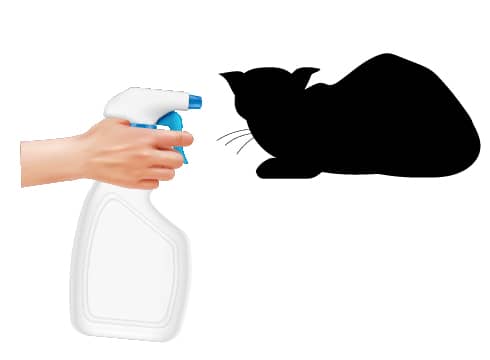

Negative reinforcement strategies do not work on cats in general. And, in the worst-case scenario, they can be entirely ineffective or even harmful. The main reason for this is because that penalties cause your cat to lose trust in you.
Many cats will become stressed as a result. Worse, they could exhibit behavior that most humans would find unacceptable.
The following are some of the possible outcomes of applying these methods:
- Urinate or defecate on rugs or personal things outside of the litter box;
- Scratch a few more places around the house;
- In the worst-case scenario, they may withdraw and hide, or they may refuse to eat.
The best thing to do is to focus on positive reinforcement.
Final Thoughts
Cats can be temperamental.
You can start with one or more of the approaches listed above, or you can use them all at once. The speed of learning will depend on your cat.
Remember that only with a deep knowledge of your cat’s behavior and a lot of love can you teach him/her not to scratch your furniture.
Training your cat can be an enjoyable experience for both of you.
Now it’s your turn!
Do you have any extra tips to share that work on how to get your cat to stop scratching furniture? If so, please share them!





